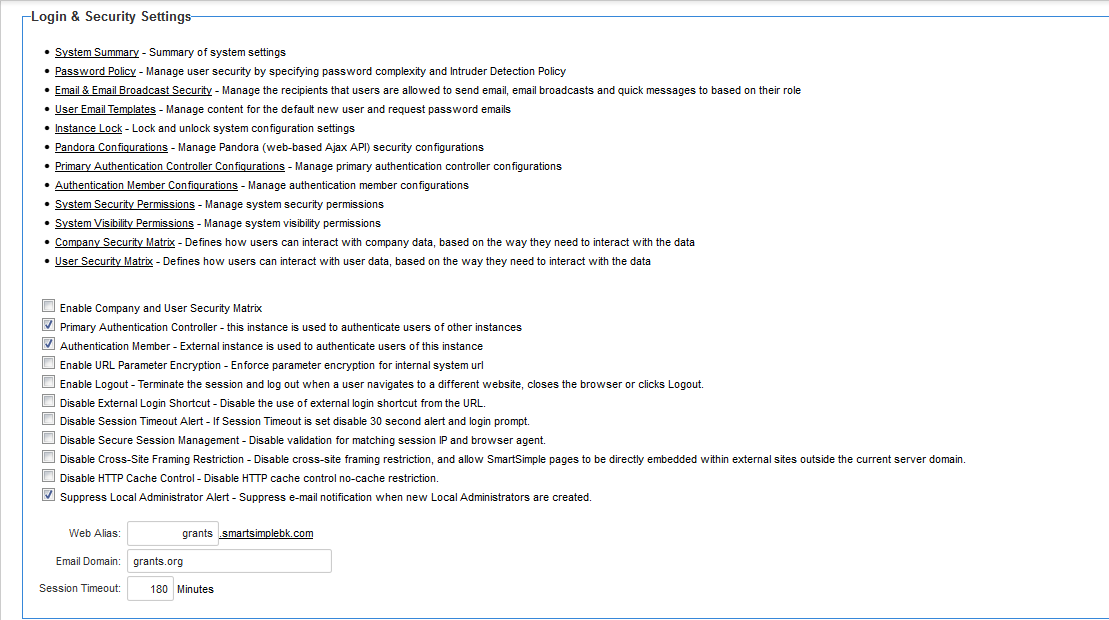Login & Security Settings
Contents
- 1 System Summary
- 2 Password Policy
- 3 Email & Email Broadcast Security
- 4 User Email Templates
- 5 Instance Lock
- 6 Pandora Configurations
- 7 Primary Authentication Controller Configuration
- 8 Authentication Member Configuration
- 9 System Security Permissions
- 10 System Visibility Permissions
- 11 Company / User Security Matrix
- 12 Enable URL Parameter Encryption
- 13 Enable Logout
- 14 Disable External Login Shortcut
- 15 Disable Session Timeout Alert
- 16 Disable Secure Session Management
- 17 Disable Cross-Site Framing Restriction
- 18 Suppress Local Administrator Alert
- 19 Web Alias
- 20 Email Domain
- 21 Session Timeout
These settings are used to control system security.
System Summary
The System Summary is a summary of system settings, broken out into a series of tabs, that supports easy to use copy and paste functionality to help when creating system documentation for an instance of SmartSimple.
Password Policy
The Password Policy is used to control the length and complexity of passwords, password expiration and history, the number of retries that the user is allowed, and the lockout time for the account if they exceed the number of retries. Click here for detailed information.
Email & Email Broadcast Security
The Email & Email Broadcast Security settings are used to control which recipients users are allowed to send email and email broadcasts to based on their role. Click here for detailed information.
User Email Templates
The User Email Templates link is used to manage content for the default new user and request password emails. Click here for details.
Instance Lock
The Instance Lock-Down provides the ability to remove access to all settings in your copy of SmartSimple using a global system-lock password. Click here for details on how to use this feature.
Pandora Configurations
Access to security settings for Category:Pandora, the SmartSimple API.
Primary Authentication Controller Configuration
The Primary Authentication Controller feature allows this instance of SmartSimple to authenticate users to gain access to a separate instance without having to log in separately (Single Sign-On). In order to do this you will need to enable the Primary Authentication Controller feature.
Authentication Member Configuration
The Authentication Member feature allows another instance of SmartSimple to authenticate users to gain access to a this instance without having to log in separately (Single Sign-On). In order to do this you will need to enable the Authentication Member feature.
System Security Permissions
Allows for system administrators to personalize their copy of SmartSimple and to make various system objects available to users in different roles.
System Visibility Permissions
Allows for system administrators to personalize their copy of SmartSimple and to make various system objects available to users in different roles.
Company / User Security Matrix
Allows system administrators to restrict interaction with the application and the associated entities. In order to do this you will need to Enable Company and User Security Matrix feature.
Enable URL Parameter Encryption
This setting will encrypt object IDs such as custom field IDs, userid, companyid, activity. This enhances security by making it impossible to guess URLs.
Enable Logout
The system can be configured to automatically logout the user and store the session end time in the user log whenever the Logout button is clicked, the user navigates to a different website or when the browser is closed.
A confirmation message can also be enabled to confirm that the user will be logged out.
Disable External Login Shortcut
This setting will disable the use of the external login shortcut (exlogin) from the URL.
Disable Session Timeout Alert
If Session Timeout is set, this setting will disable the 30-second alert and login prompt pop-ups.
Disable Secure Session Management
This setting will disable the validation for matching session IP and browser agent.
Disable Cross-Site Framing Restriction
Disable cross-site framing restriction, and allow SmartSimple pages to be directly embedded within external sites outside the current server domain.
Suppress Local Administrator Alert
The e-mail notification sent to all current administrators when a new Local Administrator is created can be suppressed.
Web Alias
The web alias defines the prefix to your copy of SmartSimple. Click here for details.
Email Domain
The Email Domain defines the default e-mail domain used when Users log into SmartSimple. More information can be found on this page.
Session Timeout
The Session Timeout controls how long a user can be inactive in their browser before they are automatically logged out by the system. See Session Timeout for more information.
